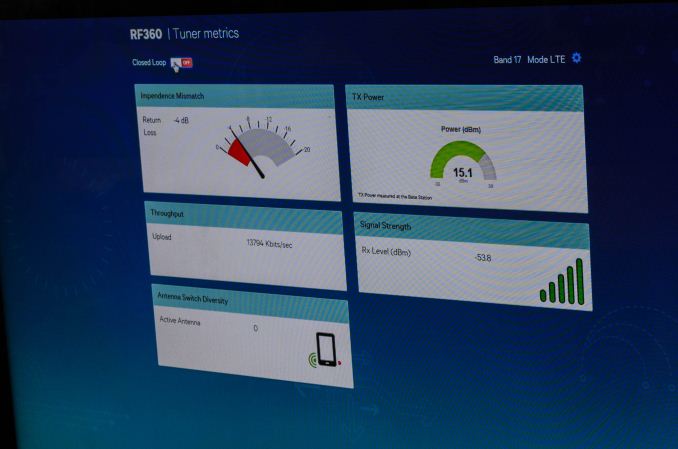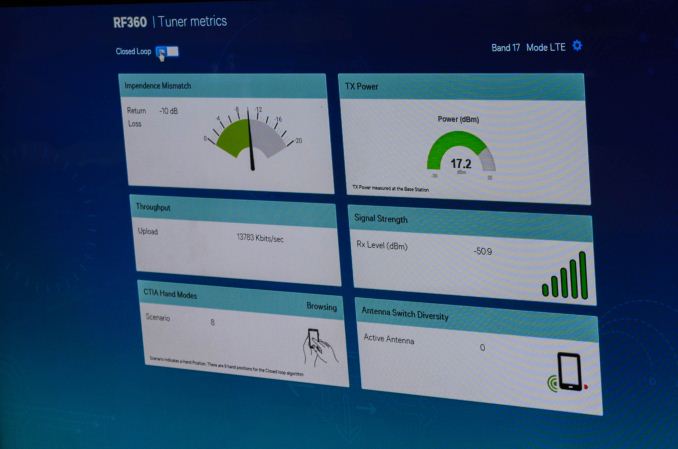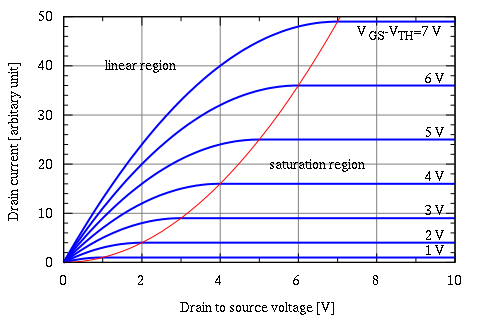Understanding Qualcomm's Snapdragon 810: Performance Preview
by Joshua Ho & Andrei Frumusanu on February 12, 2015 9:00 AM EST- Posted in
- SoCs
- Qualcomm
- Mobile
- Gobi
- Snapdragon 810
QFE2550 Antenna Tuner
One of the first areas to explore would be the RF front end, and before we jump into deep discussions we’ll tackle some of the simpler sections first. The QFE25xx antenna tuner is similar to the envelope tracker in the sense that it’s normally not part of the RF front end. I never actually mentioned an envelope tracker or antenna tuner at any step in the introduction. This is because these parts are not part of the basic superheterodyne radio system. However, like envelope tracking, the need for more battery life, faster data, and superior reception has driven the development of new technologies.
To understand how this antenna tuner works, we must introduce the concept of impedance matching and impedance. Impedance seems difficult at first, but is really just a form of resistance in an AC circuit for the purposes of understanding this article. The three components in a circuit that affect impedance are resistors, capacitors, and inductors. Impedance matching is exactly what it sounds like, which is equalizing the impedance at a junction. In transferring energy from an antenna to the RF front end, we must match the impedance between the antenna and front end. This is because if the impedances are mismatched, signal reflects back to the source. In other words, on the receiving side reception becomes weaker if impedance is mismatched, and on the transmission side energy is wasted. One can liken this to a glossy display, as while the vast majority of the light goes through the glass cover, some light is reflected back.
Of course, in the factory the RF system is carefully tuned to ensure that impedance mismatch is as low as possible. However, the real world makes for a difficult situation. The iPhone 4’s death grip behavior is a classic example of how real-world use can disrupt this impedance matching. By bridging two gaps in the metal ring of the iPhone 4, the antenna was detuned and its impedance was altered. As a result, signal became noticeably worse. Combined with the compressed signal representation, this made it possible for a “decent signal” to be completely lost by touching the right place on the phone.
This is where the QFE2550 antenna tuner and similar systems come in. By acting as a voltage-controlled variable capacitor, the baseband can be loaded with information that allows it to predict how much mismatch correction is needed for each detected scenario, which is accomplished with various sensors that can include capacitive touch sensors. Each situation is compensated for by using pre-loaded corrections that are loaded when a given scenario is detected based on frequency change or body loading scenarios. As a result, the efficiency of the antenna is restored as seen in the photo above, although the presence of body loading will inevitably reduce peak power and sensitivity. Such a system can be combined with more information, such as capacitive touch sensors or reflected power measurements to ensure maximum responsiveness and performance. This has the greatest benefit in enabling phones with all-metal unibodies, although other tools such as antenna switched diversity and MIMO can be used to ensure peak reception.
QFE33xx CMOS PA/Switch
Normally, power amplifiers are not worth talking about. However, with the introduction of RF360 Qualcomm has bandied about the concept of a CMOS PA to cover a wide swath of bands rather than just a few. While this sounds interesting, there’s a great deal more nuance to this issue than simply band coverage. First, semiconductor/solid state physics is required to really understand where the debate lies. Of course, there’s really no time to go over this in major depth, but there are a few basics. The transistor is a switch that controls the flow of current. However, there is a limit to how much current can be carried, and there are a few regions in which the relationship between voltage and current differ. The two that we’ll talk about are the linear region and saturation region. The linear region is exactly what it sounds like. Voltage and current are linearly related, following Ohm’s law. The saturation region is where this falls apart, and more voltage is needed to increase current by the same amount, and we see diminishing returns until maximum current is reached.
"IvsV mosfet" by User:CyrilB. Licensed under CC BY-SA 3.0 via Wikimedia Commons
So this is where we see a fundamental difference in the implementation of a CMOS PA and GaAs PA. Gallium arsenide has higher electron mobility, even in saturation mode. This makes it easier for GaAs circuits to switch at incredibly high frequencies such as 60 GHz for WiGig/802.11ad. In addition, unlike silicon-based transistors, gallium arsenide transistors are generally heat-insensitive, and pure GaAs has high resistance and dielectric constant, which means that it serves as an excellent substrate for various components for the same reasons that silicon-on-insulator (SOI) is a good substrate for CMOS logic. In addition, GaAs-based transistors are highly linear in behavior when compared to CMOS technologies, so a GaAs PA can operate much closer to maximum current without clipping the signal.
However, GaAs is not perfect. For one, CMOS logic is impossible to implement using current technologies. This is because unlike current CMOS technology where there are NMOS and PMOS transistors, GaAs-based transistors do not have a p-channel equivalent. As a result, the controls available over a GaAs PA are significantly cruder than what is possible with a CMOS PA. GaAs PAs are also noticeably less efficient at low power levels, also known as the backoff condition. Therefore, CMOS PAs tend to be more power efficient at lower power states as they can have multiple “maximum power states” to scale the PA as needed. In practice, Qualcomm claims that we’re still looking at around a 5-10% efficiency delta at max power when compared to GaAs PAs, which means that CMOS PAs are close to GaAs PAs in efficiency.
Despite the differences in efficiency, a CMOS PA is still a valid option in smartphones due to the fact that a single PA can cover far more bands than an equivalent GaAs PA, as the PAE curve across a spread of frequencies is relatively flat compared to a GaAs PA which is effectively a single peak. In addition, the fact that the PA is built on CMOS means that there is additional integration capability. In its current incarnation, the QFE33xx already has an integrated antenna switch, and there is potential for greater integration with parts that share a similar process node.
This concludes RF360, which gives a broad survey of what’s on the market today. Combined with our previous piece on MDM9x25, it’s possible to get a good idea of the current state of the market. However, the latest and greatest modems and transceivers mean that it’s time to talk about UE category 6, 9, and 10 LTE and the various challenges that come with new capabilities.














119 Comments
View All Comments
PC Perv - Thursday, February 12, 2015 - link
Did review state on what OS the benchmarks were run? KitKat, Lollipop, 64-bit/32-bit, etc.? Sorry if I missed it.Gigaplex - Thursday, February 12, 2015 - link
Why go through all that detail on how their software stack for big.LITTLE improves over stock ARM, without testing to see if it works? The Exynos article the other day showed that big.LITTLE flat out didn't work, performing worse than parking on little cores but consuming more energy. Does Qualcomms one actually improve things here?bigstrudel - Thursday, February 12, 2015 - link
I'm beyond skeptical of 810's performance under actual thermal constraints like inside a flagship smartphone.PC Perv - Thursday, February 12, 2015 - link
I am not sure how useful those system-level benches (Basemark, 3DMark) are to compare different platforms. On same platform (OS), I can see the value.HisDivineOrder - Thursday, February 12, 2015 - link
Given all the press runs (here, PCper) Qualcomm are doing, the loss of that Samsung contract must have REALLY got someone's knickers in a twist.blzd - Thursday, February 12, 2015 - link
Good article. Thanks for including some S800 devices in some of the device comparisons, more of that (older SoC for comparison) please if you can.tuxRoller - Thursday, February 12, 2015 - link
I'll say this once again: email Rob Clark of red hat. He's been working on a clean-room implementation of adreno (https://github.com/freedreno/freedreno) for a few years and has gotten quite far (gl 2.1/gl|es 2.0, iirc).He's a super nice guy, and given that Qualcomm has been contributing, a bit, to his project he may be loathe to harm the relationship, but, if nothing else, you can read through his repo to understand the arch.
aryonoco - Thursday, February 12, 2015 - link
Fantastic preview, thanks guys, it's been great at AT over the last couple of weeks!Just a note, in future and especially when reviewing shipping devices, could you pay some attention to the 2-year upgrade performance improvement as well? Most people (in the developed world at least) seem to be on 2-year upgrade cycles, and so it makes sense to compare the current generation to the phone that's in their hand. AT does this for desktop/laptop CPUs and GPUs (for example informing people that if you already have Ivy Bridge, there's not much performance to be gained by Haswell etc) so it would be great it if that coverage extends to mobile platforms as well (for example comparing SD810 with SD600 and the level of improvement one might expect between them).
wyewye - Friday, February 13, 2015 - link
Why no Wifi tests?You say it supports MU-MIMO and 801.22ad, but anywhere else I read only "ac" and MU-MIMO is supported.
PC Perv - Friday, February 13, 2015 - link
Page 6, after the Geekbench floating-point chart, you said:"In this case Snapdragon 810 performance is relatively close to Exynos 5433 performance even though it has the advantage of running in AArch64 mode, which should give the FP numbers a boost over the Exynos. This is likely an isolated case where the Krait architecture and Snapdragon 805's high clock speed play to its favor."
And I have no idea what you are saying. I do not want to sound rude, but this kind of writing is what I saw from previous articles written by Mr. Ho (and Mr. Chester).